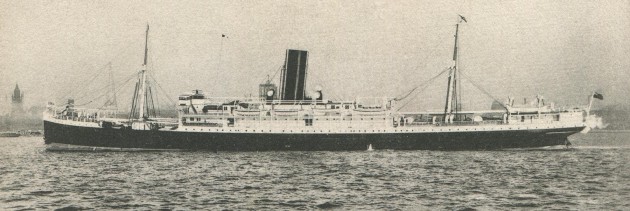…where east meets west
- Home
- Brief History
- The Greenwich Meridian
- Greenwich
(1675–1958) - Herstmonceux
(1948–1990) - Cambridge
(1990–1998) - Outstations (1822–1971)…
- – Chingford (1822–1924)
- – Deal
(1864–1927) - – Abinger
(1923–1957) - – Bristol & Bradford on Avon
(1939–1948) - – Bath
(1939–1949) - – Hartland
(1955–1967) - – Cape of Good Hope
(1959–1971)
- Administration…
- – Funding
- – Governance
- – Inventories
- – Pay
- – Regulations
- – Royal Warrants
- Contemporary Accounts
- People
- Publications
- Science
- Technology
- Telescopes
- Chronometers
- Clocks & Time
- Board of Longitude
- Libraries & Archives
- Visit
- Search
General Relativity and the 1919 Solar Eclipse
© Robin Catchpole (Institute of Astronomy, Cambridge) & Graham Dolan
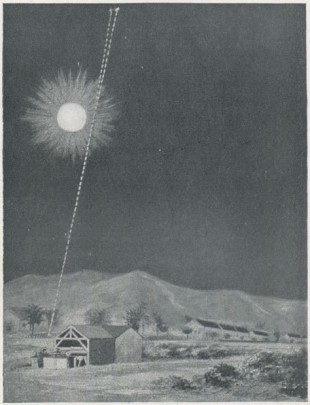
Contemporary graphic showing the deflection of starlight by the sun. Believed to have been compiled from a composite of two photographs taken at Sobral, it is similar to an illustration that appeared in The Illustrated London News on 22 November 1919. From Hutchinson’s Splendour of the Heavens (1923) where it is credited to E.N.A.
Special and General Relativity
Einstein published his theory of Special Relativity in 1905 and his General Theory in 1915. One of the predictions of the General theory, is that the Sun will displace the images of nearby stars by an amount;
displacementradian = 4GM⊙/c2r ≡ 1.75′′ r⊙/r
Where r⊙ is the radius of the Sun and r the radial distance from the centre of the Sun. On the other hand, assuming that the energy of light is subject to gravitation in the same way as ordinary mass, Newton’s theory, predicts half the displacement. While a third option was that there would be no displacement at all.
Solar eclipses and the hunt for evidence
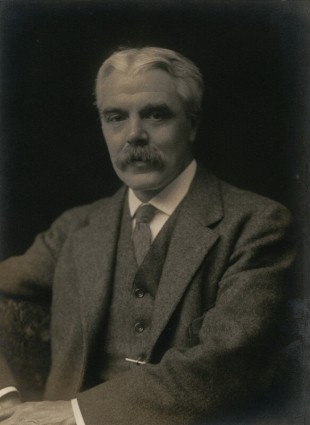
Frank Dyson, Astronomer Royal and chairman of the joint standing eclipse committee of the Royal Society and Royal Astronomical Society. Bromide print by Walter Stoneman, 1919. © National Portrait Gallery, London. Reproduced under a Creative Commons Attribution-NonCommercial-NoDerivs 3.0 Unported (CC BY-NC-ND 3.0) licence (see below)
Einstein’s theory had successfully explained a small discrepancy in Mercury’s orbit around the Sun, but his prediction of the gravitational redshift of absorption lines in the Sun had not been confirmed.
Kennefick (2012) suggests that the few physicists and theoreticians, such as Eddington who understood Einstein’s theory, needed no observational proof, but many astronomers, including Dyson and the wider world were highly sceptical of the theory, so the results of the 1919 eclipse would be crucial to its acceptance. Kennefick also puts to rest any suggestion that Eddington selected his results to support Einstein’s prediction.
An unsuccessful attempt was made to measure the deflection, by a group from the Lick Observatory at the total eclipse of 8 June 1918.
The line of the 1919 total eclipse crossed the equator, stretching from South America to Uganda, giving almost 6 minutes of darkness, during which the Sun and surrounding stars could be photographed.
A British expedition was organised under the direction of Dyson. It was decided that two groups of two observers would be sent. One group, consisting of staff from the Royal Observatory, Greenwich, went to Sobral in Brazil. The second group, from the Cambridge Observatory, went to the Island of Principe, a small volcanic island 220 km off the West African coast. The Greenwich group consisted of Andrew Crommelin and his more junior colleague Charles Davidson. The Cambridge group consisted of the Observatory’s Director, Arthur Eddington, and Edwin Cottingham who looked after the Observatory’s clocks. The expeditions were supported and partially funded by the joint standing eclipse committee of the Royal Society and Royal Astronomical Society.
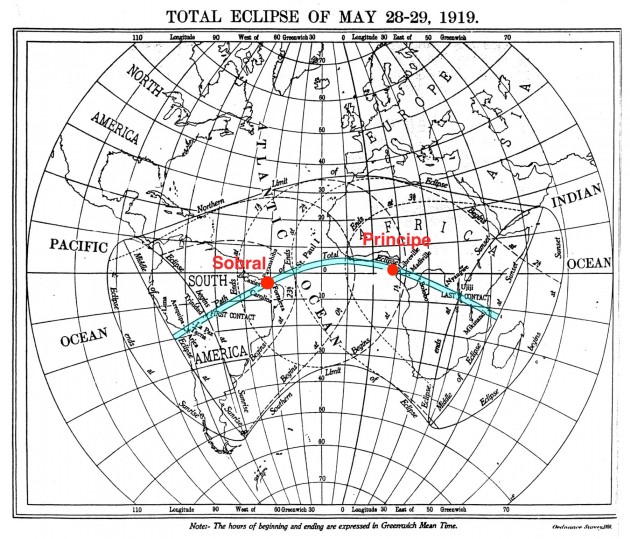
The line of the 1919 total eclipse crossed the equator, stretching from South America to Uganda. Image adapted from the The Nautical Almanac for the year 1919 (see note at bottom of page)
The departure from Liverpool – 8 March 1919
Both parties convened at Greenwich and then left Liverpool together on 8 March 1919 on the SS Anselm . At Madeira, Eddington and Cottingham embarked on SS Portugal for Principe, while Crommelin, and Davidson continued on the Anselm arriving at Para (now called Belem), on the 23 March. Since they had time to spare they decided to continue the trip in the Anselm, another thousand miles up the Amazon to Manaus. Crommelin (1919) comments on ‘the luxurious forests of the Amazon, with their denizens of gorgeous plumage’ returning to Belem on the 8 April. From there they took a ship 580 miles east along the coast to Camocim and then the train, for the final 70 miles to Sobral, arriving on 30 April. At Sobral they were joined by an eclipse party from Washington and another from Brazil.
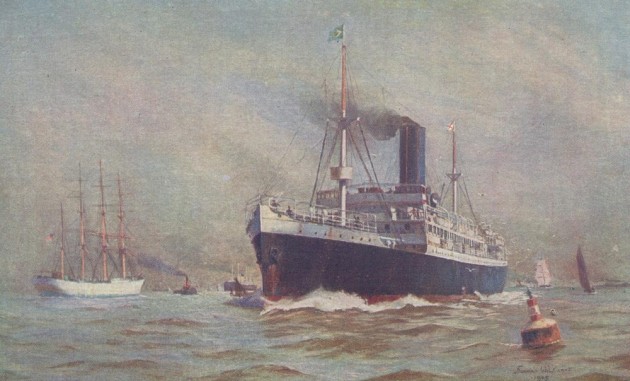
The Anselm. Launched in 1905 and operated by the Booth Line, the ship was sold to Argentina and renamed in 1922. Painting by Norman Wilkinson, 1905

The Astrographic Refractor at Greenwich. Only the object glass was taken to Sobral. Photo by the London Stereoscopic and Photographic Company c.1896, From the Greenwich Astrographic Catalogue, Volume 1, (HMSO, 1904)

Side view of the Eros Micrometer (which was designed to measure the photographic plates taken with which Astrographic Telescope). Plate 15 from Monthly Notices of the Royal Astronomical Society, Vol. 64 (1904)
The equipment taken
Both parties took identical 13-inch astrographic lenses of 11 feet 3 inches focal length. That taken to Sobral came from the Astrographic Telescope at Greenwich. That taken to Principe came from the Astrographic Telescope at Oxford. The object glasses were attached on arrival to hollow steel tubes (made by Harvey & Co.), with the lens at one end and the photographic plate holder at the other and then mounted horizontally so that the sunlight could be reflected into them by a 16 inch diameter flat mirror.
The flat mirror or coelostat, was slowly rotated to follow the Sun, using a clock driven by a heavy weight, that ran for about half an hour before the weight had to be rewound. Both astrographic lenses were stopped down to 8 inches diameter to improve their image quality.
The Greenwich Sobral group, also took a 4 inch diameter lens with a focal length of 19 feet, loaned to them by Father Cortie. This was fed by an 8 inch diameter coelostat loaned by the Royal Irish Academy. The Greenwich group also took a 3½ inch Detached Telescope (R.O. No. 3) and the Eros Micrometer.
Mounting the telescope horizontally avoids the need to transport and align a heavy equatorial mount and makes it easier to keep the apparatus cool and free of wind shake, but the flat coelostat mirror introduces an extra optical element, capable of spoiling the image quality.
The Sobral expedition
Having arrived in Sobral, Crommelin and Davidson selected a convenient site for their observing shed just in front of the house where they were staying. Located on the race-course of the Jockey Club, their chosen site had the advantage of a nearby covered grand stand that they were able to use for unpacking, storage and preparatory work.
Although the coordinates of the Greenwich observing site do not appear to have been recorded and the race-course no longer exists, an examination of surviving photographs showing its position relative to surviving buildings (Figs 2 & 10, in Crispino (2018)), suggests that the Greenwich observing site was located at the point indicated on the map below (3.692164S, 40.352800W).
Three days before the eclipse, it rained heavily settling the dust and clearing the sky. Totality started at about 9 in the morning. The day started cloudy and then cleared during totality except for a minute in mid eclipse, when there was thin cloud. The thin cloud reduced the brightness of the Sun, enough to show a large prominence on the limb on one of the their plates.

The Royal Observatory's observing site on the race-course at Sobral. The two horizontal tubes in the shed are the two photographic telescopes mounted in their observing positions. The 13-inch object glass from the Astrographic Telescope at Greenwich is mounted in the (circular) tube on the left. The 4-inch Cortie lens is mounted in the (square) tube on the right. The two coelostats used with them are mounted on the plinths in foreground (which are aligned north south). The object on the pillar on the far left is the driving clock for the larger of the two coelostats. It's job was to turn the mirror so that the Sun's light continued to be reflected into the telescope as the Sun moved across the sky. Photo by Charles Davidson
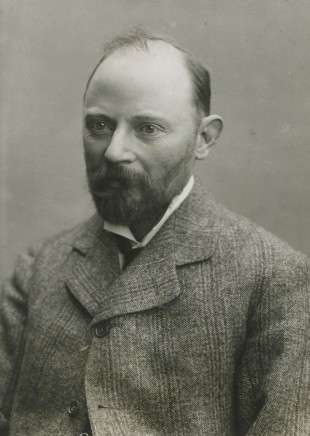
Andrew Crommelin in about 1915. As originally planned he had not been scheduled to take part in the expedition. He was a late substitute for Father Cortie (Director of the Stonyhurst College Observatory) who was unable to spare the necessary time. Photograph by Elliott & Fry
The 19 plates taken with the astrographic lens were very disappointing, the star images appearing diffused and out of focus. This was put down to the distortion of the coelostat mirror caused by the heat of the Sun. Assuming the blurring was due to a change of focal length, gave a result close to Newton’s, while assuming the focal length had not changed, gave a result closer to Einstein, both with such a large uncertainty that the results were discounted.
After the eclipse, the Sobral group packed away their equipment and went back down the coast to Fortaleza, returning on 9 July, when the stars they had observed around the Sun would be at the same altitude but in the dark pre-dawn sky. They set up their equipment and took more plates, to compare with the eclipse plates. One plate was exposed with the plate back to front, meaning that the star light passed through the glass before forming an image in the emulsion. This plate was then placed emulsion to emulsion, first with the eclipse plates and then the star field plates and the differences in star positions were measured. Images obtained before dawn with the astrographic lens were found to be in perfect focus, suggesting that the problem had indeed been with the coelostat.
The Sobral team finally returned to Greenwich on 25 August.
The Principe expedition

Arthur Eddington, Plumian Professor of Astronomy and Experimental Philosophy at Cambridge, Director of the Cambridge Observatory and member of the Board of Visitors and former Chief Assistant at the Royal Observatory, Greenwich. Photo c.1914 by Elliott & Fry. From Hutchinson's Splendour of the Heavens (1923). Also published on 28 March 1914 by The Illustrated London News
At Principe on 29 May, the day of the eclipse started with a very heavy thunderstorm which finished at 11:30. The sky began to clear just before totality at 14:13 and was briefly completely clear. Stars appeared on 7 of the plates and the remainder showed good images of the prominence. Only two plates were off sufficient quality and gave results consistent with Einstein’s prediction.
Because of an impending strike by the steamship company, Eddington and Cottingham left Principe on 12 June and got back to Liverpool via Lisbon on 14 July.
They would have had to wait almost 6 months in Principe for the Hyades to appear in the night sky at the same position as they had during the eclipse, so the calibration plates of the eclipse field were taken with the astrographic, earlier in January and February that year, at Oxford, where the telescope was normally sited.
After the eclipse, Eddington was also able to enjoy some of the pleasures of Principe. He wrote to his mother (Eddington papers A4/9); ‘lunch on the beach off fish which we watched being caught’. ‘All the beaches are very pretty - a strip of golden sand between the cocoanut palms and the blue sea. I had a good bathe at Lapa – the only time in Principe & a black man went with me to see that I did not go too near the sharks.’ Other outings included, a Monkey Hunt at which no monkeys were seen and a trip to the ruined palace and church of a famous female slave dealer (Maria Correia) on the beach near Bom Bom.
Returning home on the SS Zaire, Eddington wrote to his mother; ‘ But the one good plate that I measured gave a result agreeing with Einstein and I think I have got a little confirmation from a second plate’ (Eddington papers).
Announcing the results
One 12 September Eddington attended the British Association for the Advancement of Science meeting in Bournemouth, where he showed the eclipse plates with the spectacular prominence and mentioned that measurements made to date indicated a deflection somewhere between the predictions of Newton and Einstein (Observatory Magazine, 1919, 42, 361).
On 27 September Einstein (collected papers) wrote to his mother; ‘Today some happy news. H. A. Lorentz telegraphed me that the English expeditions have really verified the deflection of light by the Sun’. Before going on to ask after his mother’s health.
The results of combined observations from Cambridge and Greenwich were finally announced to the world at a joint meeting of the Royal Society and Royal Astronomical Society on 6 November 1919 (Observatory Magazine. 1919, 42, 389). They were subsequently published in Dyson, Eddington & Davidson (1920). In this paper Diagram 2 (below), based on the Sobral results with the 4 inch Cortie lens, convincingly shows that the variation of displacement with distance from the Solar limb closely follows Einstein’s predictions and differs significantly from Netwon’s prediction.

Enhanced version of diagram 2 from Dyson et al. 1920, showing the observed shifts (blue dots) of stars measured on the 4 inch Cortie telescope plates, compared to the predictions of Einstein and Newton as a function of the distance of the stars from the centre of the Sun.
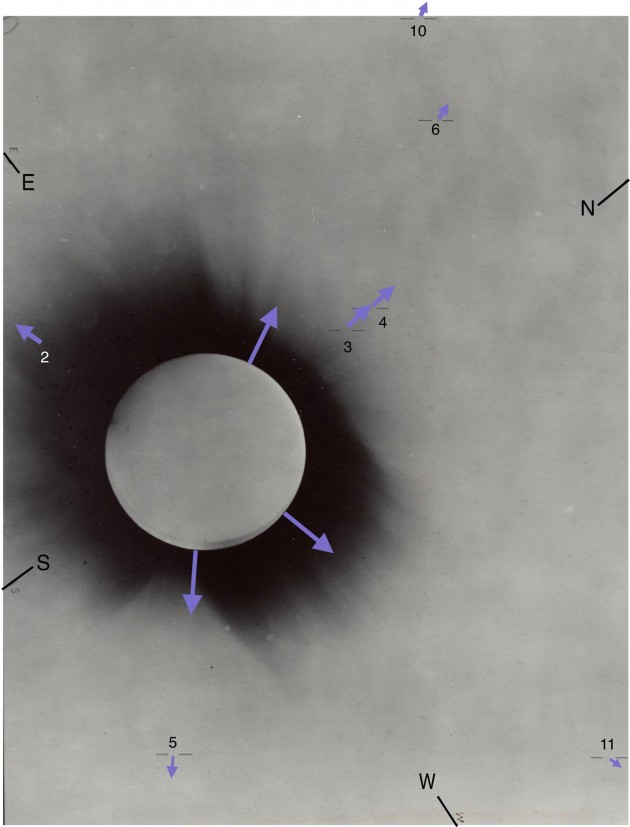
An acetate copy of one of the 4 inch Cortie telescope plates, showing the magnitude and direction of the deflections predicted by Einstein's theory magnified 320 times, for various stars.

Enlarged image of star 4 from one of the 4 inch Cortie telescope plates. The red arrow shows the shift of 0.75 seconds of arc predicted by Einstein for this star
Contemporary barriers to a ready acceptance of the theory seem to have been twofold. Firstly, the reported non detection of the gravitational redshift in the Sun by St John (1917) and the feeling that a fundamentally new theory should allow itself a simple explanation, not requiring sophisticated mathematics. The gravitational redshift in the Sun (0.6 km s-1 ) is made difficult to detect by the convective motion of gasses at the surface of the Sun. Gravitational redshift has since been measured in white dwarf stars and in the laboratory.
Although Eddington is the name most associated with this eclipse and its success in confirming Einstein’s prediction, his results would have been of little value, without the observations made by Crommelin’s party from the Royal Observatory, Greenwich.
Einstein in England – June 1921

Einstein (left) and Haldane. From a photo by Walter Benington. Originally published in The Sphere on 18 June 1921, it was later reproduced in Hutchinson’s Splendour of the Heavens (1923)
The following day, he went to London, where he was the guest of the former Labour Lord Chancellor and fellow of the Royal Society, Richard (Viscount) Haldane, who accompanied him to a meeting of the Royal Astronomical Society (chaired by Eddington) and then co-hosted a dinner for the Einsteins at his house in Queen Anne’s Gate with his sister. According to The Times, the following guests also attended: Randall Thomas Davidson, Archbishop of Canterbury; Charles Sherrington, president of the Royal Society; Frank Dyson, the Astronomer Royal; Joseph J Thompson, Eddington, Professor Whitehead; Ernest Barker, the Principal of King’s College; Lady Horner; Dr Freudlich; Edmund Gosse; Professor JS Haldane, Haldane’s brother, and Graeme Haldane, Haldane’s nephew. The Prime Minister was unavoidably prevented from attending. After the dinner, a number of other guests arrived for a reception, including George Bernard Shaw.
Over the following days, Einstein attended many other events (some with Haldane and some without), before returning to Berlin on 17 June. They included laying a wreath on Newton’s grave in Westminster Abbey on 13 June.

Einstein came back to England several times in the early 1930s. In this shot, taken in June 1930, he is in conversation with Eddington in the garden of the Observatory at Cambridge. From a photo attributed to Winifred Eddington
Remeasurement of the plates in 1979
In 1979, Harvey (1979) reported the re-measurement of five of the original seven, 4 inch, and all 16 original astrographic plates from Sobral, using modern measuring machines. He obtained essentially the same result, although in the case of the astrographic camera plates with much improved accuracy.
Observations of gravitational lensing from the Hubble Space Telescope and GAIA
Today, the Hubble Space Telescope has shown many beautiful examples of the gravitational lensing of distant galaxies by foreground clusters of galaxies, which provide one of the lines of evidence for dark matter. General Relativity has also be tested by the timing of Quasar occultations by the Sun, the decrease in orbital period of binary pulsars (PSR B 1913+16) and most recently the direct detection of gravitational radiation from merging neutron stars and black holes.
The GAIA satellite, which measures the position of stars a million times more accurately than the deflection of star light at the edge of the Sun, must allow for the gravitational effect of the Sun over the whole sky, as well as for the effect of the gravitational deflection of the Earth Moon and remaining planets. Its observations will provide a stringent test of the predictions of General Relativity.
A more through discussion of the 1919 eclipse results has been given by Longair (2015).
Further reading
The paper by Dyson, Eddington and Davidson announcing the results of their eclipse expeditions was published jointly by the Royal Society (Philosophical Transactions) and the Royal Astronomical Society (Memoirs of the Royal Astronomical Society), the later being a reprint of the former, with both the original and a new set of page numbers.
The paper as published contained a number of errors and omissions. These were corrected by means of an Errata Slip which has not been digitised in the online versions. A transcript of the text on the Errata Slip follows the two links below.
A determination of the Deflection of light by the Suns gravitational from observations made at the total eclipse of May 29, 1919. Dyson, F. W., Eddington, A. S. & Davidson, C., 1920, Phil. Trans. R. Soc., 220, 291.
A determination of the Deflection of light by the Suns gravitational from observations made at the total eclipse of May 29, 1919. Dyson, F. W., Eddington, A. S. & Davidson, C., Memoirs of the Royal Astronomical Society, Vol. 62, Appendix, A1– A43 (1923)
| Errata | |||
| Page no. |
|||
| [3]=293 | add to Table 1., The co-ordinates of the Sun’s centre as seen from Sobral are x=+0.436, y=-0.263. as seen from Principe are x=+0.553, y=-0.246. |
||
| [6]=296 | longitude of Sobral, for 47m read 41m. | ||
| [13]=303 | Star 2, column 1., for 0.789 read 0.798. | ||
| [13]=303 | foot of column VIII., for 1.322 read 1.332. | ||
| [13]=303 | Star 2, column 142a, for 0.396 read 0.346. | ||
| [17]=307 | insert r at top of columns where omitted. | ||
| [17]=307 | comparison 142b, first column, for 0.008 read 0.018. | ||
| [19]=309 | Star 6, first column, for +0.10 read -0.10. |
Additional contemporary accounts etc.
The eclipse of the Sun on May 29, Crommelin, A. C. D. 6 Feb 1919. Nature 102, pp.444–446
Eddington papers, A4/9, Trinity College, Cambridge, Library
The eclipse expedition to Sobral. Crommelin, A. C. D. Oct 1919. Obs. Magazine 42, No 544, p.368
Collected Papers of Albert Einstein, Vol 9, The Berlin Years, Correspondence, Jan 1919 – April 1920, page 98, letter 113. Princeton. Eds. Buchwald, D. K., Schulmann, R., Illy, J., Kennefick, D. J., Sauer, T.
The principle of generalized relativity and the displacement of Fraunhofer Lines toward the red. St John, C. E., 1917, ApJ, 46, 249
More recent works
Ninth Astronomer Royal – A life of Frank Watson Dyson, pp.191–94. Margaret Wilson (1951)
Expeditions for the observation in Sobral, Brazil, of the May 29, 1919 total solar eclipse. Crispino, L. C. B., 2018, Int. J. Mod. Phys. D, 27 No 11, 1843004. (paywall)
Gravitational deflection of light – a re-examination of the observations of the solar eclipse of 1919. Harvey, G. M., 1979, Obs. Magazine, 99, 195
Not Only Because of Theory: Dyson, Eddington, and the Competing Myths of the 1919 Eclipse Expedition. Kennefick D. (2012). In: Lehner C., Renn J., Schemmel M. (eds) Einstein and the Changing Worldviews of Physics. Einstein Studies, vol 12. Birkhäuser Boston
Bending space-time: a commentary on Dyson, Eddington and Davidson (1920) ‘A determination of the deflection of light by the Sun's gravitational field’. Longair, M., 2015, Phil. Trans. R., Soc., A373:20140287
Collected papers based on the presentations at the 7th international conference on the history of general relativity, La Orotava, Spain, March 6–13, 2005. Beckman and Eric Stengler.
Books published in 1919 (in order of publication)
No shadow of a doubt: The 1919 eclipse that confirmed Einstein’s theory of relativity. Daniel J Kennefick (2019)
Gravity’s century: From Einstein’s eclipse to images of black holes. Ron Cowen (2019)
Einstein’s war: How relativity triumphed amid the vicious nationalism of World War I. Matthew Stanley (2019)
Proving Einstein right: The daring expeditions that changed how we look at the universe. S. James Gates & Cathie Pelletier (2019)
A note on the eclipse map (above)
At the 1911 Congress Internationale des Ephemerides in Paris, the five principal ephemeris-producing nations (France, Germany, Great Britain, Spain and the United States) agreed to co-operate in the production of almanac data, with the aims of avoiding duplication of effort and of standardising the basis upon which the ephemerides were computed. This arrangement came fully into force in the publications for 1916. The 1919 eclipse map (above) was prepared by the British Ordnance Survey (from data presumably supplied by HM Nautical Almanac Office) and sent out to the various nations for inclusion in their almanacs. Click here to view the 1919 map as it appeared in the American Ephemeris and Nautical Almanac. Click here to view it as it appeared (in cropped form) in the Connaissance des temps ou des mouvements célestes à l'usage des astronomes et des navigateurs.
For reasons, as yet unexplained, the continent of Africa was misdrawn. An erratum was published in 1918 in the editions for 1921. It reads as follows:
‘The coast line of Africa, bordering on the Gulf of Guinea, should be 2º further south, between 9º E. and 12º W.’
The map as reproduced above has been hand ‘corrected’, by a person unknown – possibly by Dyson, Crommelin or Davidson. The colouring was added in 2019 for the purposes of this website. Curiously, the map for the annular eclipse of 22 November 1919, which was published in the same volumes and was also prepared by the Ordnance Survey, does not repeat the error. Click here to view it as published in the American Ephemeris.
Acknowledgements
The following image is © National Portrait Gallery, London. Reproduced under a Creative Commons Attribution-NonCommercial-NoDerivs 3.0 Unported (CC BY-NC-ND 3.0) licence.
Portrait of Frank Dyson. Bromide print by Walter Stoneman, 1919. National Portrait Gallery Object ID: NPG x88116.
© 2014 – 2025 Graham Dolan
Except where indicated, all text and images are the copyright of Graham Dolan
